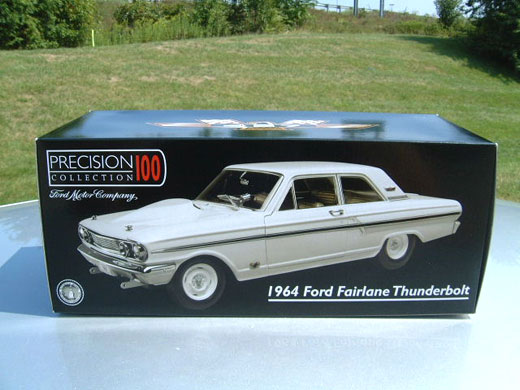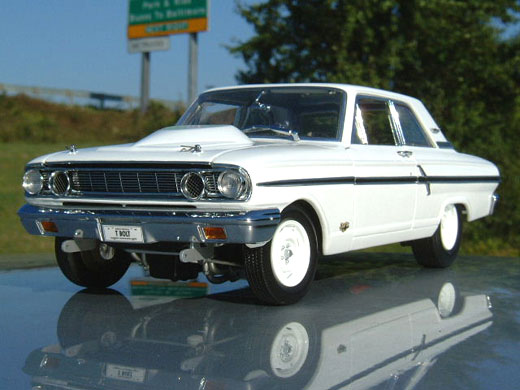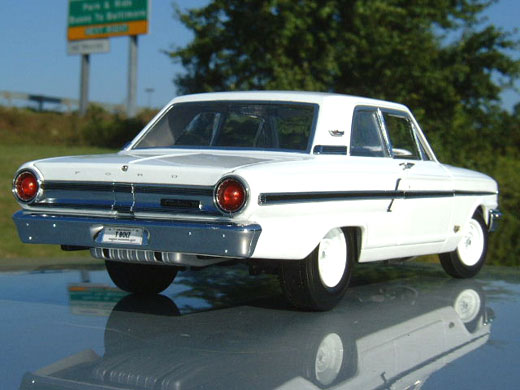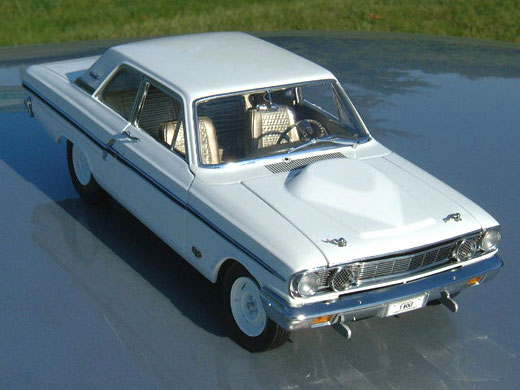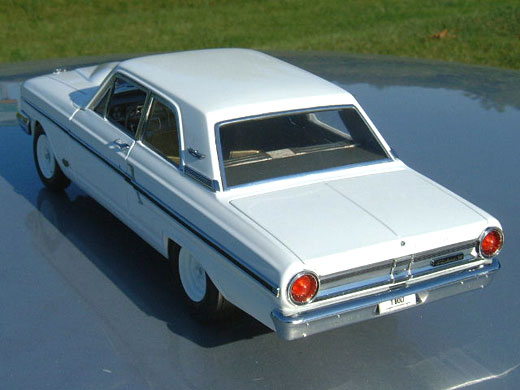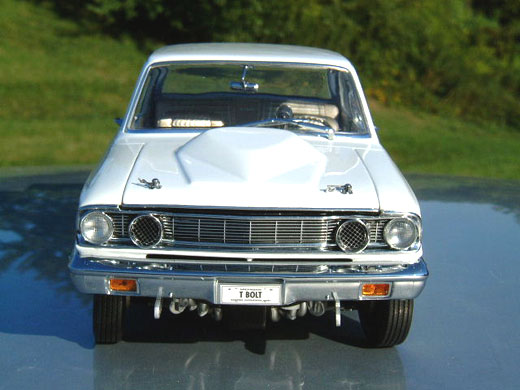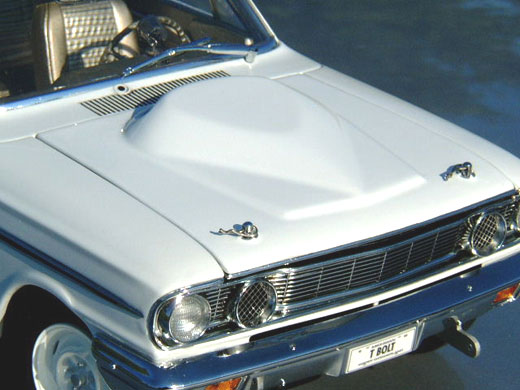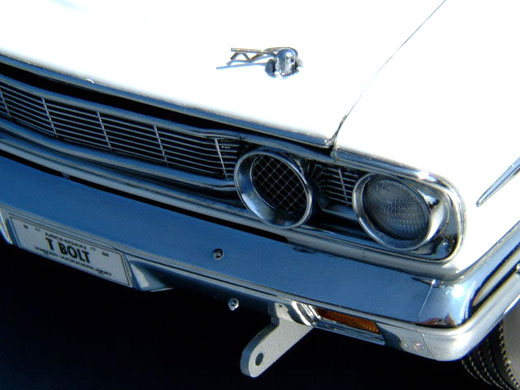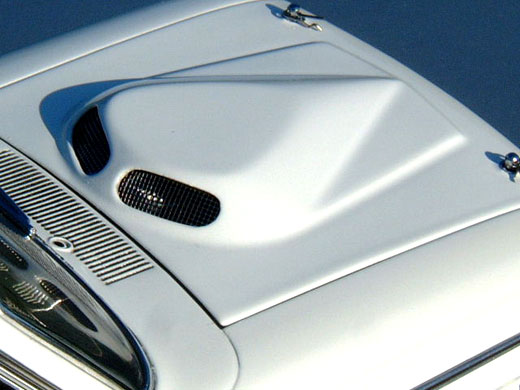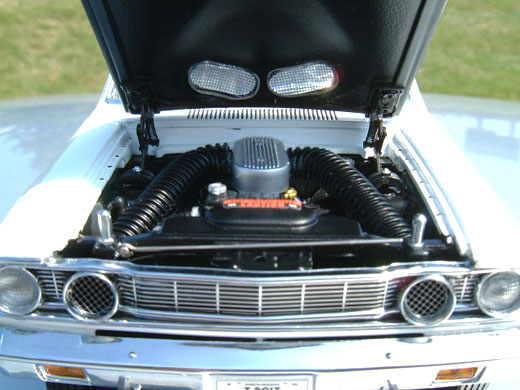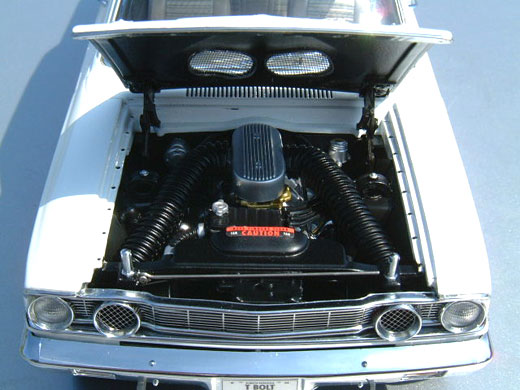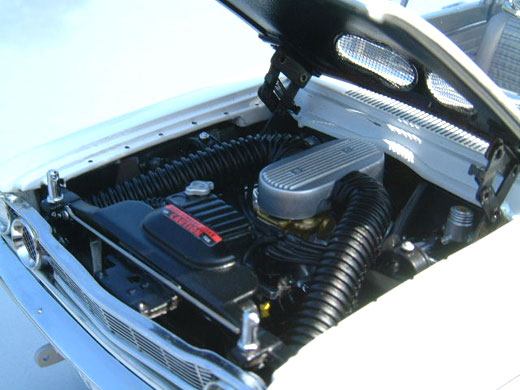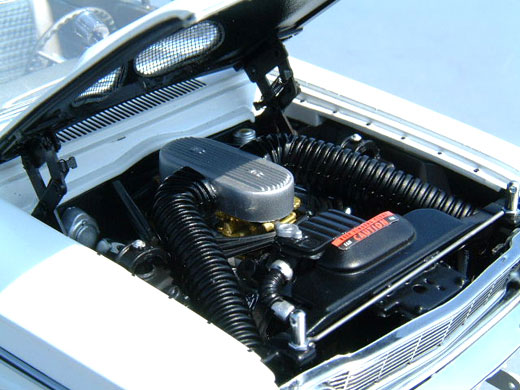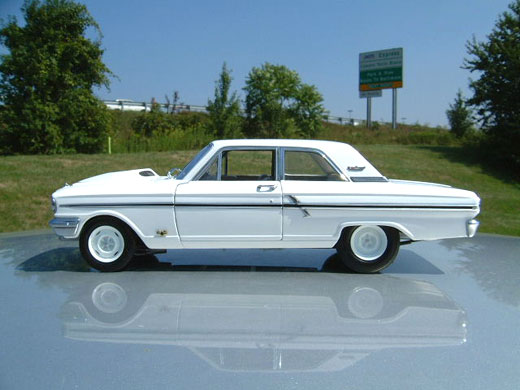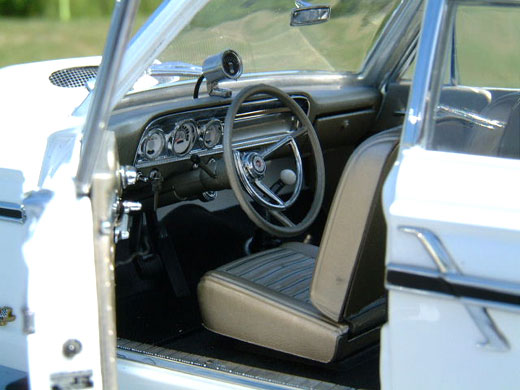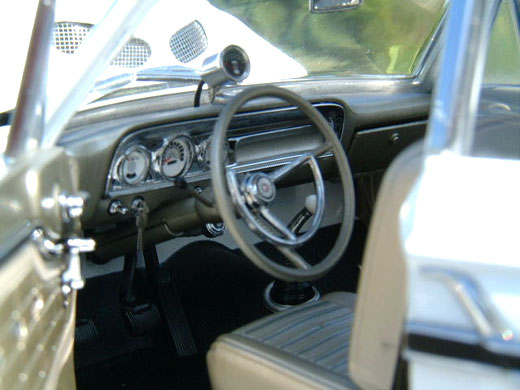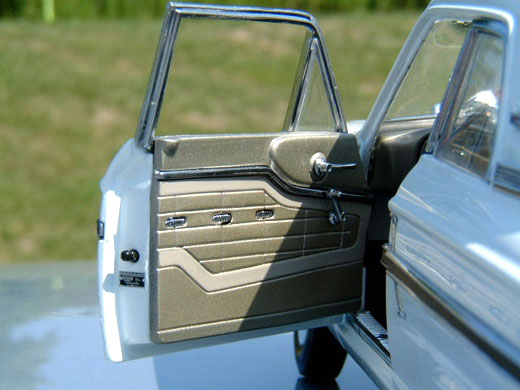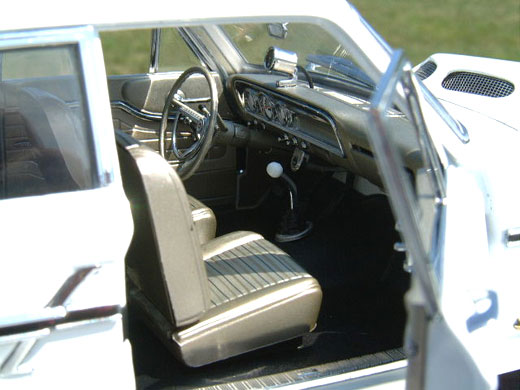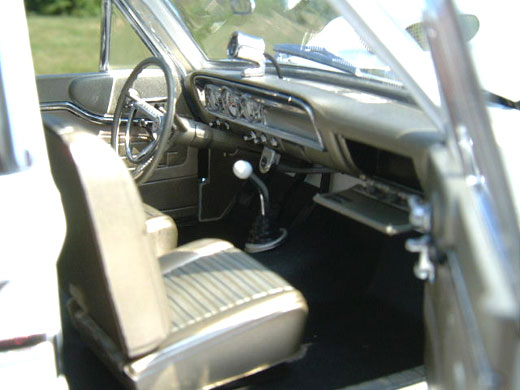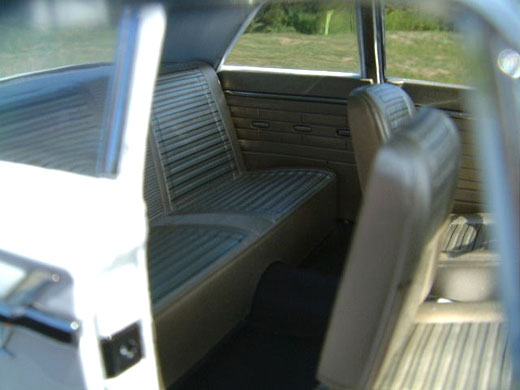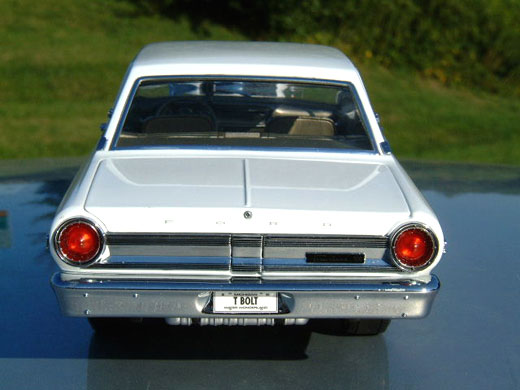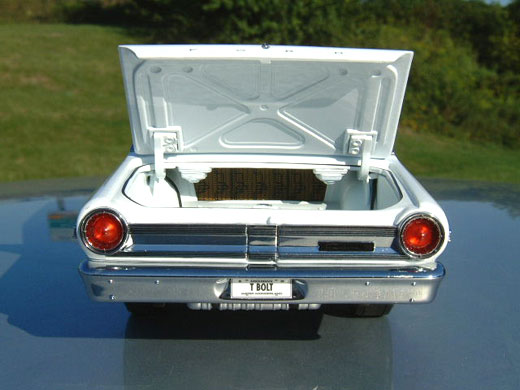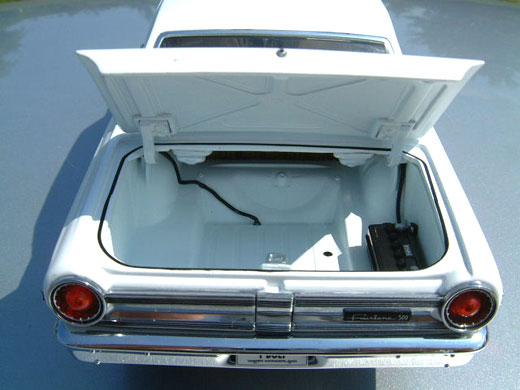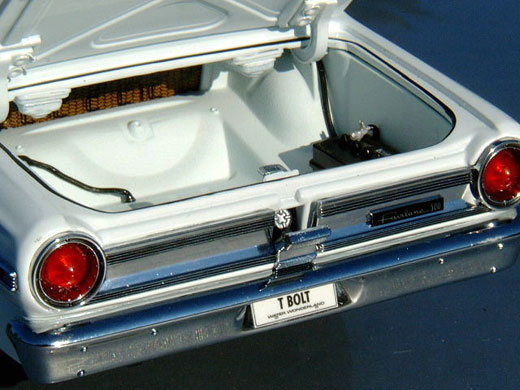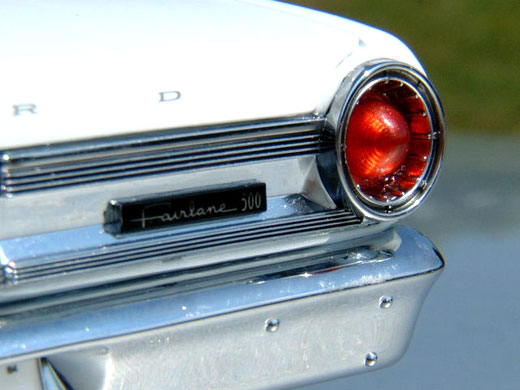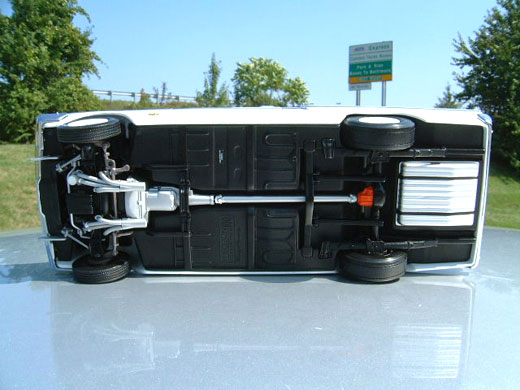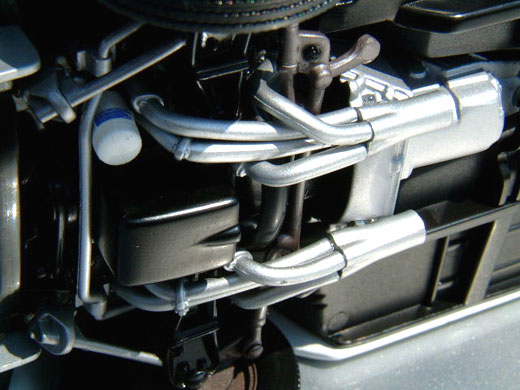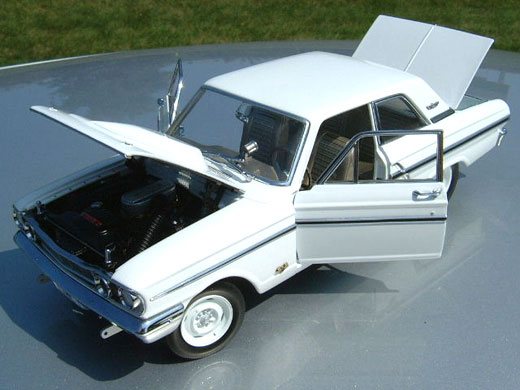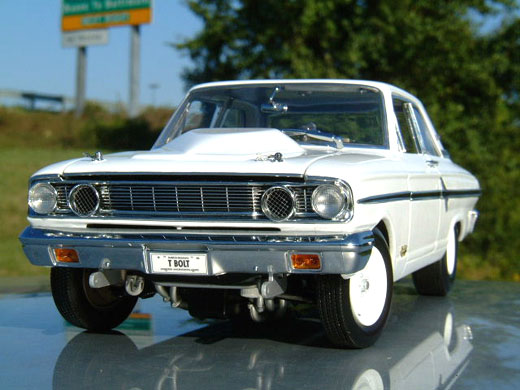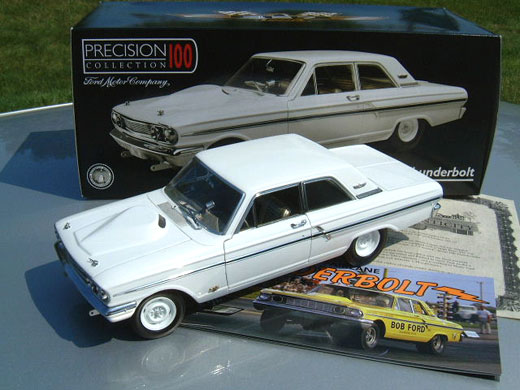|
|
 Sanctioned Drag Racing, born in the early 1950’s, quickly became a live advertising tool used by automakers that wanted to sell their cars. Drag Racing proclaimed whose cars were hot, and whose were not. The Big Three battled ferociously for bragging rights each and every Sunday with their own stable of factory backed racers. The fight for Undisputed Champion was a roller coaster ride for each automaker, each having their own highs & lows. The boys at Ford were king of the hill early with the Flathead V8, but would be dethroned a short while later by Chevrolet’s birth of the small-block V8. Ford's exile from the throne would last for several years, thanks in part to the conservative attitude of the then Lord of Ford, Robert McNamara. Sanctioned Drag Racing, born in the early 1950’s, quickly became a live advertising tool used by automakers that wanted to sell their cars. Drag Racing proclaimed whose cars were hot, and whose were not. The Big Three battled ferociously for bragging rights each and every Sunday with their own stable of factory backed racers. The fight for Undisputed Champion was a roller coaster ride for each automaker, each having their own highs & lows. The boys at Ford were king of the hill early with the Flathead V8, but would be dethroned a short while later by Chevrolet’s birth of the small-block V8. Ford's exile from the throne would last for several years, thanks in part to the conservative attitude of the then Lord of Ford, Robert McNamara.
In 1957, the Automobile Manufacturers Association (AMA) passed a ban on factory backed drag racing brought about by the increasingly bad press and threats from Washington regarding auto safety. The voluntary industry wide ban was more about good PR than actually banning factory backed racing. GM & Chrysler agreed to the ban, albeit with their fingers crossed behind their backs. However, it was McNamara’s decision that Ford would take the ban much more seriously. The prudent McNamara believed the automobile should be used only for it’s most basic function, sensible transportation from point A to point B. Performance & Luxury were qualities that McNamara purposefully eluded. McNamara’s reserved attitude resulted in a tarnished black & blue oval that dragged Ford down and out of the racing spotlight.
The blemishes on Ford's Blue Oval Brigade would soon fade away with the appointment of a new General Manager at Ford in 1960, Lee Iacocca. Just as McNamara’s ideal car was the simplistic Ford Falcon, Iacocca’s was the hoof-thumping pavement pounding Mustang. Iacocca’s inauguration as Ford’s new blue oval boss man marked a turning point that would see Ford reign supreme once more. 1960 was a year of change for Ford and performance was on its way up within the company, but by 1960, many of Ford's competitors were at the top of their game and Ford was left with a lot of catching up to do.
While Ford was busy with R&D, improving their cubic inch displacements and power to weight ratios, other automakers were busy taking home the trophies. 1961 was the year of Chevy’s 409, 1962 was a split between the 409 and the Pontiac 421 Super Duty, and 1963 went heavily to Mopars 426ci Max Wedge. Ford's victory record was on the incline throughout these 3 years, but they came in a dollar short and a day late. All of Ford's research would eventually pay off. The shining light struck through the gray clouds over Ford in 1963 with the birth of Ford's monstrous 427. Ford built the 427 with one priority in mind, to win races. For 1963, Ford dropped the Galaxie on the two-lane blacktop hoping to quiet the loud noise coming out of the Mopar camps. The Galaxie was successful for Ford on the Nascar circuits, packing the heavy hitting high rise 427. The Galaxie underwent several weight modifications to the point that it was a bare bones super lightweight racer. Ford’s principal was a weightless car with a ton of horsepower will fly down the track in blistering fast speeds and ultimately grasp the championship out of Mopars tight clutches. It was a good principal, but even with all of the weight modifications, the Galaxie was still too heavy to haul ass. So Ford went back to the drawing board and cooked up the idea of putting the Galaxies larger displaced hi-riser 427 into an intermediate size car, a formula made popular in the Muscle Car history books by the Pontiac 64 GTO. What Ford was about to drop on the automotive & racing worlds was their version of the atomic bomb.
Ford's catalyst was the intermediate sized Ford Fairlane. First, the Fairlane would go through the same rigorous diet that it’s Galaxie sibling underwent. All non-essentials such as sun visors, outside mirrors, sound deadener, armrests and the radio were deleted. Even the rear window cranks, jack and lug wrench were removed to conserve weight. The front seats were swapped out for a pair of lightweight buckets borrowed from Ford's Econoline light truck series. All of the lyposuction procedures were performed on Ford's assembly lines; further procedures were farmed out to nearby Dearborn Steel Tubing, the same contract company Ford used for the modifications made on the Galaxie.
Dearborn Steel Tubing (DST) was put in charge of putting the final touches on the heavily modified Fairlane, including further weight reduction measures and the actual heart transplant. DST dropped the total weight on the Fairlane by replacing several body parts with fiberglass and aluminum components. The doors and front body panels were swapped out for fiberglass replacements and the bumpers were exchanged for aluminum equivalents. DST went a step further and replaced all of the glass on the Fairlane, save for the front windshield, with Plexiglas. All of these weight modifications got the Fairlane down to NHRA’s weight minimum of 3205 pounds. While the Fairlane underwent several weight reductions, DST added a few necessary pounds to the Fairlane such as a bolted on pair of traction bars and a beefed up front suspension. Once the weight modifications were complete, the final step was to load the Fairlane with its pavement pounding artillery, the hi-rise 427.
Locking & loading the Fairlane with Ford’s hi-rise 427 proved to be a situation of rocket science. The fit was tighter than a gnat’s ass. The surgeons at DST had to rework the front suspension to clear the gargantuan 427 once they got it squeezed down inside the Fairlanes not so accommodating engine compartment. Then, the eight equal length exhaust headers had to be routed through the front suspension. Once the talented DST docs were able to get the huge 427 crammed into the tiny Fairlane, the next obstacle they had to overcome was the height of the hi-rise 427. DST’s solution was a raised reverse teardrop fiberglass scooped hood that gave enough clearance to the 427’s massive intake. Speaking of the intake, DST replaced the inner headlamps with dual screened ram air intakes that fed cool air through a pair of flexible hoses that led to a large air chamber that rested over the 427’s carbs. The addition of forced cool air to the hungry 427 gave the Fairlane enough boost to “twist the frame” on a good torque induced tire tearing trip down the two lane blacktop. All of this hard work, both by Ford & DST, resulted in the Ford Fairlane “Thunderbolt”.
Ford's “Act of God” was initially reproduced 11 times in robes of burgundy with tan interiors. Each of the original 11 Thunderbolts were contracted out to established drag racers like Gas Ronda, Dick Brannen, and Mickey Thompson. The remaining balance of Thunderbolts to be built after these 11 were finished in a plain jane wimbeldon white. Ford planned to build only 50 Thunderbolts for NHRA A/FX racing, but ultimately built over 100 copies, enough to qualify the Thunderbolt for Super Stock class racing, where the Thunderbolts would find themselves most successful. Gas Ronda won the 1964 NHRA World Stock Eliminator title and Phil Bonner won the AHRA Mr. Stock Eliminator title, both in their very own Thunderbolt. The Thunderbolt was known for average elapsed times of 11.80 seconds, cranking out a factory claimed 425hp that was later estimated to be closer to 500hp. The Thunderbolt put Ford back to the top of their roller coaster ride
The rolling thunder of the Ford Thunderbolt started to fade in 1964, to be replaced by the earth pounding galloping of Ford’s new & highly popular stallion, the Mustang, which packed a newly developed single overhead cam 427. On the street, the rumble was settling as well. Not many consumers were willing to take the $3900 plunge required to own one of these brutal blue oval machines, nearly twice the price of a standard issue Fairlane. With interest lacking on the street and the decrease in number of appearances at the strip after 1964, the Thunderbolt became nothing more than a storm passing by. Nonetheless, it was a violent storm that left its mark. Today, the Thunderbolt is revered as one of the most memorable factory backed drag cars of its day.
Almost 40 years later, another storm is brewing on the blue oval horizon. Smaller in scale, but equally as potent, this latest storm is blowing in from Dyersville, Iowa in the form of the RC/Ertl built Precision 100 1/18 scale diecast model 1964 Ford Thunderbolt. Even before this miniature scale replica car is removed from its box; you can hear the rolls of thunder crashing. This little Thunderbolt is bound to blow your doors off. The Thunderbolt is packed in a glossy black rectangular box with an actual size picture of the car on the front and smaller pictures of the Thunderbolts details on the back. On the top is the simplistic but aggressive looking racing bird emblem with 427 branded on its breast. Remove the styrofoam shell from the box and on top is a bright brochure that opens to reveal some really neat pictures and history of Ford's “Special Event Acceleration Vehicle”. You’ll also find a very authentic certificate of authenticity from the Henry Ford Museum & Greenfield Village. Ford & RC/Ertl went all out on the Thunderbolt diecast model car, packing in all the bells & whistles they could. But the best whistle of all is yet to be found inside the styrofoam shell. Let’s open it and have a peek.
The electricity of the Precision 100 Thunderbolt will strike with a charge that will send your senses on high alert. You’ll want to spend as much time as possible looking, touching and even smelling the Thunderbolt, making sure not to miss any detail. The Precision 100 Thunderbolt has taken high detail to another level, a familiar trait of the Precision series replicas. First things first, the mandatory “first impression” inspection. RC/Ertl has captured the look of the 64 Thunderbolt with drop dead accuracy. The shape of the body, the contours of the raised teardrop hood, the glowing interior with it’s zillion electroplated chrome accents, the impressive photo etched front grille work and the mega realistic looking head and tail lights proclaim an award worthy performance from the folks at RC/Ertl. The wimbeldon white paint is smooth and rich, void of any chips scratches dings or blemishes. The exterior is finished off with a few sharp looking electroplated chrome pieces including a trimmed spear of lightning that runs the length of the car, plus a miniature “thunder”-bird 427 crest that rests on the lower side of the front fender. All of this beauty rests upon a set of white steel wheels with detailed lugs wrapped in a set of skinny rubbers up front and a pair of slicks in back. Lastly, unless your nose is plugged, you will be taken with the aroma of that familiar new car smell that seems to surround the entire car in a dreamy cloud of it’s rich perfume. Upon completion of the “first impression” inspection, this auditor’s summation is simply – “WOW”
After recovering from the jaw dropping induced side effects of the viewing pleasure that is RC/Ertl’s Precision 100 1964 Ford Thunderbolt, further inspection is impossible to resist. Be prepared to pick that jaw up several more times. Starting up front, it’s hard to look past the hood and front grille area. Both of these pieces have been replicated with incredible attention to detail. The grille is a plethora of photo etched and electroplated detailing with jewel like headlamps. The inboard headlamps are void, as with the original, and in its place, photo etched detail in the form of cross hatch screens that are open to allow air to pass through to dual ram air tubes located under the hood. Speaking of the hood, the shape of the raised reverse teardrop hood is perfect, accented with two open scoops that are finished with more photo etched mesh screens. The best detail on the hood, and perhaps one of the neatest little details on the Thunderbolt are the REAL miniature hood pins. The chrome-plated anchors are mounted to the leading edge of the engine compartment and poke up through the holes in the hood. There are tiny pinholes in each anchor for the hood pins to fit through. Be forewarned these pins are tiny, and it takes a little pressure to remove them and put them back in. It’s very easy for them to slip out of your fingertips and shoot off into the infinite distance. Nonetheless, it’s a very neat detail that is very welcome to the Thunderbolt. So let’s carefully remove those hood pins and take a look at what’s underneath.
THUMP!!! OOPS, There goes that jaw again. The high detail on these Precision 100 diecast cars never stops, and the engine detail RC/Ertl has packed in on the Thunderbolts hi-rise 427 is some of the best work yet. First off, the entire underhood is finished in a textured flat black paint, as are the very realistic spring-loaded hood hinges. The plastic ram air tubes and detailed air chamber take center stage over the painted carbs that rest upon the wired and plumbed 427. Other “easy-to-see” details in the engine compartment include several cast metallic painted accents to several little details such as the radiator cap and hose clamps, the metal prop for holding the hood up (although the replicas hinges do a pretty good job all their own), plus a Caution label on the fan shroud. Other than that, the rest of the details are hard to see do the accurately replicated constricted environs of the 427, so tight in fact, it’s a little hard to see down “through” the engine compartment. What's more, you have to turn the car over to view the detailed oil filter, which is appropriately crammed between the front sway bar and the cast metallic painted open headers that twist and turn around the suspension components, just as DST had to do on the original. The 427 is mated to a diecast tranny that is in turn mated to a rotating driveshaft that functions as you turn the rear wheels. It too is finished in a coat of cast metallic paint, as is the gas tank. Other details on the undercarriage include diecast tow bars up front, black traction bars in back, a functioning coil spring suspension system, and the rear housing is finished in a coat of orange paint. It’s an amazingly replicated package, and it doesn’t stop here.
With some string tied around your head to keep your jaw in place, go ahead and open the doors on the Thunderbolt, which by the way, operate on those fantastic realistic functioning door hinges. Everything about this interior says attention to detail right down to the turning window cranks on a set of the most detailed door panels to date. The golden interior is finished with several chrome accents focused mainly around the dash, which is nothing short of a work of art. The highly legible gauges are recessed in a wall of chrome that is itself recessed in a gold painted dash with a wired chrome plated Ford Rotunda tach resting upon it. The dash is finished off with an opening glove box, sliding ash tray, several chrome-plated knobs and doohickeys, an oil pressure gauge on the underside of the dash that has a direct line running to the 427 through the firewall, plus the Precision signature pair of keys in the ignition. All of this rests upon a gold painted steering column that culminates at an elegantly detailed mix of gold & chrome steering wheel. The lightweight buckets slide and fold forward providing access to the rear bench seat. All of the seating is finished in gold with gold & cream horizontal bars, accented with a blue pin stripe. With the chrome trim on the door panels and side panels in the back seat, the look is very eye catching. The rest of the interior is complimented with a simulated rubber flooring just like the original, real chrome sill plates, detailed shifter, dome light, and the accurate drivers side only sun visor. The passenger side sun visor was a further delete to conserve weight, just as the passenger side windshield wiper was; another detail accurately captured on the RC/Ertl Precision Thunderbolt diecast model car. If you feel a little overwhelmed with all of the intricate little details RC/Ertl put into this diecast replica, welcome to the party. Unfortunately our trip through the land of heavenly detail is almost over.
The last point of inspection on our Thunderbolt is the trunk. Now with all of the neat little functioning details on the Thunderbolt, I almost expected the trunk to literally “pop” open. But, alas, it doesn’t. Inside however is yet another “best yet” nomination for one of the greatest applications of high detail on a trunk. For starters, when you open the trunk, amidst all of the white, you’re eyes will immediately focus on a small patch of light orange deep inside the trunk. At closer inspection, you’ll see miniature black painted springs on the patch of orange. What Ertl has done is captured what the rear side of the back bench seat looked like through the trunk. There was no back wall to the trunk, so what you saw was the rear cushioning of the seat and the springs. The addition of this detail is incredible. The trunk is finished in flat white with a rough texture feel. The trunk is finished off with a wired truck battery mounted on the right side of the trunk, a detailed trunk lock, a chrome plated trunk catch, and a molded housing around the pipe leading from the gas cap to the tank. Speaking of the gas cap, it can be found behind an opening door in the rear tail light panel that rests between two bright red afterburner taillights and a Fairlane 500 plaque.
You can finally rest your jaw. That is until you go back over the Thunderbolt to find any details missed in this review, and believe me, the Thunderbolt is going to require several re-visits. The Thunderbolt institutes many new “firsts” for a high detail car, and continues to improve upon some already great details. Just as the original Thunderbolt was created to put the Ford name back on top, the replica version of the same car is bound to do the same for RC/Ertl. The original Thunderbolt came and went in a very short time although it’s rumble was heard by many. Likewise, the 1/18 scale RC/Ertl Precision 100 1964 Ford Thunderbolt, like a severe thunderstorm that quickly blows over, is bound to make a lot of noise but disappear swiftly. Fortunately, with the announcement of the RC/Ertl / Precision 100 / Supercars 1964 Gas Ronda Thunderbolt, we’ll see first hand that lightning truly can strike twice. |
1964 Ford FairlaneThunderbolt (Precision 100) Ertl
|
|
Total diecast model cars in 1964 Ford FairlaneThunderbolt (Precision 100) Ertl: 0
|
|




